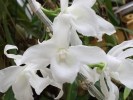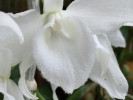|
|
|
|
| Register Yourself at Meyers Conservatory |
To register yourself with the Meyers Conservatory web site, please click the button
below and follow the instructions. You may just make a simple registration with your
email address and a password, but to use the advanced features like the Wish List
you should follow the registration process all the way into the User Information Page
where you can specify plants you are interested in and decide what kind of notifications
you will get.
|
|
|
|
|
| |
Flasks of
Dendrobium anosmum var. alba 'MC7326' × self |
|
| |
|
|
| |
| Number: |
TN8388 |
| Name: |
Dendrobium anosmum var. alba 'MC7326' × self
|
| Type: |
self (What's that?) |
|
Seed Donor: |
Troy C. Meyers
|
|
Click to Enlarge

Pod Parent Flower |
Click to Enlarge

Pod Parent Closeup of Flower |
|
|
|
| |
Comments: Parent plant: One of the offspring from our TN2374 effort of 2001.
For additional origin/habitat information supplied courtesy of
Charles and Margaret Baker, see further below, near the bottom of this page.
|
Temperatures we attempt to use in the lab & greenhouse:
| For Species: |
|
Spring, Summer, Autumn, Winter: days average 82°F, nights 64°F; best fit is Intermediate 83-60°F
(Source:
Baker's Web OSC) |
|
About the name...
| Etymology of |
alba |
|
From Latin "albus" white.
(Source:
Brown 1956) |
| Etymology of |
anosmum |
|
From latinized Greek "anosmus" odorless.
(Source:
Mayr & Schmucker 1998) |
| Etymology of |
Dendrobium |
|
From Greek "dendron" tree and "bios" life.
(Source:
Pridgeon 1992) |
| Pronunciation of |
alba |
|
AL-ba
(Source:
Hawkes 1978) |
| Pronunciation of |
Dendrobium |
|
den-DRO-bee-um
(Source:
Pridgeon 1992) |
|
If you would like to direct someone to this web page, please copy and paste this URL into your email:
http://troymeyers.com/d?018388
| Flask Information |
| Availability: |
We have sold all of the flasks for this item. |
| You should: |
Consider getting individual plants or compots instead of a flask.
See if we have plants available in the greenhouse. |
| Yield Estimate: |
638 plants (based on flask surveys done 11/07/2017 through 11/25/2019)
|
| Plantlet Sizes: |
From many flasks 30 - 80 mm plants (based on flask surveys done 08/08/2018 through 03/04/2021)
From one most recently surveyed flask 40 - 80 mm (03/04/2021)
|
|
You might also want to:
|
View the seed assay for this item.
See if we have plants available in the greenhouse.
View items of the same species.
View items of the same genus.
|
| Ordering Information |
| You are not currently logged in. |
|
You must be a registered user and be logged in to reserve a flask or place a notification request. Please log in:
|
|
| Register Yourself at Meyers Conservatory |
To register yourself with the Meyers Conservatory web site, please click the button
below and follow the instructions. You may just make a simple registration with your
email address and a password, but to use the advanced features like the Wish List
you should follow the registration process all the way into the User Information Page
where you can specify plants you are interested in and decide what kind of notifications
you will get.
|
|
|
|
|
|
|
|
| |
The origin/habitat information below is supplied courtesy of Charles and Margaret Baker
The following information is based on the name of the plant provided by the donor, and assumes that the name is correct. If the plant has been misidentified, then the following information may not be correct.
This text is copyrighted by the Bakers and may not be reproduced without permission.
ORIGIN/HABITAT: Widespread. Plants are found from the Philippines to New
Guinea, including Borneo and many islands in Indonesia. They are also
found in Malaya, peninsular Thailand, Laos, Vietnam, and Sri Lanka. On
Luzon Island and in Davao Province on Mindanao Island in the Philippines,
plants grow in mountain forests usually below 2450 ft. (750 m). D. anosmum
often grows in association with Aerides quinquevulnerum and Anota
violacea. In Papua New Guinea, plants are common in the Bulolo and Wau
areas where they grow on rough-barked trees from sea level to 4250 ft.
(0-1300 m).
More about this information and the Bakers...
|
|
|
| |
|
|
|